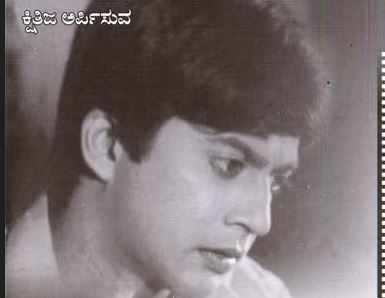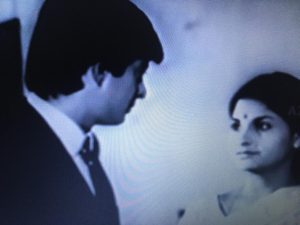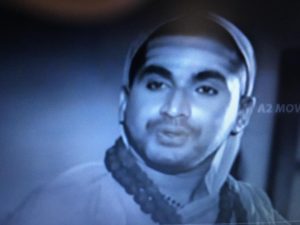
How ‘Sankalpa’ carved a niche for itself in Kannada cinema history
PV Nanjaraje Urs' film delineates the complex theme of conflict between theism and rationality

As many as 23 landmark films in the history of Kannada cinema, including Bidugade, Gandhada Gudi, Swayamvara (all three with Dr Rajkumar in the lead role), and Yedakallu Guddada Mele (directed by Puttanna Kanagal), were released in 1973. All these films will complete 50 years this year.
Among these films, Sankalpa (‘Determination’, 1973), directed by P V Nanjaraje Urs, which delineates the complex theme of conflict between theism and rationality stands apart from the rest. Sankalpa carved a niche for itself in the history of Kannada cinema, as it continued the art film tradition initiated by Samskara (directed by Pattabhirama Reddy, which pioneered the parallel cinema movement in Kannada) in the 70s.
Sankalpa can be described as a ‘movie of first timers’. Except for music composer Vijayabhaskar, for everyone who worked on Sankalpa, it was their debutant attempt at celluloid medium. Ananth Nag (then Ananth Nagarakatte) began his film career through this film. A teacher-turned-filmmaker P V Nanjaraje Urs, S Ramachandra, a graduate from Film and Television Institute of India (FTII) Pune, and film editor Umesh Kulkarni started their engagement with the visual medium through Sankalpa.

Actor Sundar Krishna Urs, and noted technician R K Prasad, assisted Nanjaraje Urs in directing this movie. Interestingly, Sankalpa is the only film Nanjaraje Urs has directed so far and has not directed any film after that.
Seven Karnataka state film awards
Besides Ananth Nagarakatte and Bindu Jaidev in the lead roles, theatre and amateur actors, including C R Simha, Vishwanatha Shastry, Anantharam Macheri, Professor Shankar, journalist Krishna Vattam, B R Venkataram, Sarojamma, Chitra and Baby Brinda jointly contributed for the success of the film.
Because of the combined efforts of talented and brilliant minds, Sankalpa secured seven Karnataka State Film awards in categories, including music, cinematography, editing, sound-recording, direction, story, and screenplay, besides best child artist in 1974. Viewers of Kannada cinema, who had grown accustomed to new wave films by this time, were shocked by the way Nanjaraje Urs communicated such a complex issue so effectively, aesthetically and cinematically.
Relevance of Sankalpa and the question of faith
Sankalpa came three years after Samskara (1970) was released. Though both delineated the “question of faith,” they differed respectively in their treatment. But Sankalpa is more relevant now than before, as the appeal of mythology, which is eternal, has taken centre stage in Indian societal structure and the lines between myth and history, culture and religion are fast fading away. Even the Supreme Court firmly rejected any attempt to lead the court to interpret religious doctrine in an absolute and extreme form and question the faith of worshippers.
It was possible to make Sankalpa kind of films, which questioned ‘Babas’ and ‘Sadhus,’ who claimed to be religious saints and heads of religious mathas in the pre-Emergency period. But, it seems, making films of this kind in the present circumstances is nothing but inviting trouble from both constitutional (Central Board of Film Certification) and extra-constitutional forces.
Thesis and anti-thesis of black and white format
The 117-minute Sankalpa was made in black and white. Making a film in black and white was much suited for art and experimental films of the 70s, as it was basically cost-effective compared to films made in colour (films like Sharapanjara, Bangarada Manushya, Naagarahaavu were made in colour) at that time.

The other reason is the popular belief prevalent then that the film produced in black and white will get an ‘experimental movie’ tag. Most of the parallel filmmakers of that period, including, Satyajit Ray, Ritwik Ghatak, Mrinal Sen, G Aravindan, John Abraham, and others were opting for this two-colour format.
In fact, watching black and white arty films were considered elitist at that time because of the long shots and silence. It was also believed that only selected few, who had been regular to European and French films screened by film societies, would understand the language and grammar of parallel films. For ‘commoners’, it was believed, it would be boring as they could not bear movies that had fewer dialogues and ‘no action’. But films such as Samskara, Vamshavruksha, and Abachoorina Post Office proved that it was disbelief and ignorance of the misguided cine-goers.
Samskara and Vamshavruksha were well received by all sections of society; producers recovered their investment and infused confidence among others to experiment in black-and-white format. People welcomed films with experimental tags just because time was ripe for that kind of movies. Bhoodana, Naandi, Chandavalliya Thota, Sandhya Raga, Bangarada Hoovu Sarvamangala, Gejje Pooje, Hannele Chiguridaaga, which were released in the late 1960/, prepared a perfect pitch for films such as Samskara and Sankalpa. In terms of their making, qualitatively and in terms of content and presentation, they achieved excellence.
Songs, which accentuated their aesthetic quality, were the only additional factor, compared to films categorized as “parallel films. While Samskara is based on a novel written by U R Ananthamurthy, the genesis of Sankalpa is just an idea.
Also read: Sundance 2023: ‘Fair Play’ is a stellar, breathless indictment of the ‘nice guy’
Sankalpa was released at a time when intellectual churning had just commenced and Navya (modernist) literature movement was just gotten off the ground, because of the indulgence of writers, including Ananthamurthy, Girish Karnad, Gopalakrishna Adiga, Shanthinatha Desai, Shankar Mokashi Punekar, Yashavantha Chittala. Similar was the state of theatre because of B V Karanth, Adyarangacharya, Lankesh and others. It was the time when rationalists such as Abraham Thomas Kovoor questioned the legitimacy of ‘godmen’ such as Maharshi Mahesh Yogi at the national level and atheists such as H Narasimhaiah and took on ‘revered’ saints such as Sai Baba in Karnataka.
The genesis of Sankalpa
At this juncture, Prof. Nanjaraje Urs, a college lecturer in Mysore, who was enamoured by films of Satyajit Ray, Ritwik Ghatak, and Mrinal Sen, resolved to make a film on the lines of these Bengali filmmakers, who changed the direction of cinema in India. As Urs was interested in theatre and cinema, he, along with his friends, founded Mythri Films Limited to produce a movie of their choice. Inspired by a film by Satyajit Ray, they planned to make a film based on an incident that occurred in Mysore.
In October 2020, the Filmmakers United Club (FUC) coordinated a panel discussion on Sankalpa. Significantly, Sankalpa is a less-dissected film in the history of the Kannada parallel cinema movement, compared to films made during that period. Urs, who was also a noted historian, filmmaker and veteran journalist N S Shankar, and film theorist and documentary filmmaker Parameshwar Guruswamy participated in this webinar (the writer of this article was also one of the panelists).
In the course of the discussion, Urs shared his experience of making Sankalpa. “In the late 60s, the films of Satyajit Ray, Mrinal Sen and Ritwik Ghatak were being screened at Alankar Theatre in Bangalore (now (Bengaluru). Such kinds of films were being screened only as morning shows (to make space for regional Kannada films and other language films, especially popular Hindi films) as only a few interested film enthusiasts and cine-buffs, were watching the kind of experimental films. I watched Devi, a film by Satyajit Ray made in 1960, based on a short story by Provat Kumar Mukhopadhyay, at Alankar Theatre. It had shaken me to the core as I was witness to a similar kind of incident in Mysore. Keeping Devi’sframework and based on the incident that happened in Mysore, I wrote a story and screenplay titled Devara Kannu.
The result of Puttanna’s challenge
Though Urs wanted to direct the film, his friends, especially one Basave Gowda, owner of a single screen in Mandya, who knows about the economics of cinema, wanted a popular director to make this movie. Names of Puttanna Kanagal, a star director, and T V Singh Thakur popped up during the discussion.
Finally, they decided to ask Puttanna Kanagal to direct Devara Kannu. Kalyan Kumar and Jayanthi were contacted for the lead roles. “But by the time, the film went to the sets, producers of this crowdfunding venture got frustrated with the tantrums thrown by Puttanna Kanagal,” recalls Urs.
“During a discussion over the script, Puttanna declared that ‘only a Brahmin could make an experimental film and for others, it is an impossible task’ and refused to make Devara Kannu. I took it as a challenge and decided to make a film on the script developed by me for nearly a year,” he adds.
Umarabba, a good-looking student of Urs, (who later became an MLA), was chosen for the role of protagonist Raju. However, Ananth Nag, who was introduced by Y N Krishnamurthy (Editor of Prajavani daily, popularly known as YNK), got the chance to essay the most complex and sensitive lead role of the film. Recalling his first engagement with the big screen Ananth Nag in an interview with Deccan Herald (April 12, 2019) said: “While I was busily engaged in Marathi and Kannada theatre in Bombay, a telephone changed course of my life. I was asked to contact YNK in Bangalore for a lead role in a Kannada film and thus Sankalpa became my first film”.
Interestingly, Urs was also a part of the progressive movements of the time, which questioned the existence of god and miracles being performed by godmen. He even claimed to have asked Sai Baba to turn a lemon into an ash guard. This background might have influenced Urs to make a movie on the lines of Devi. “Though the film was initially titled Devara Kannu, we decided to rename it as Sankalpa on the editing table because of a meaningful dialogue in the movie”, Urs explains. Sankalpa, made under Kshitija Productions banner, with an investment of Rs 1.32 lakh, is a daring attempt to explore the conflict between theism and rationality.
The storyline
While Shastry has a conservative outlook, his son Raju is a psychotherapist and rationalist. For Raju, there is nothing abnormal or supernatural in this world. He gives a rational explanation for everything that appears to be unusual. He treats many cases in his clinic. Bhagavan Balayogi Baba, who comes to their house, exhibits supernatural powers. He claims to cure all sorts of diseases.
Raju rejects that by citing the theory of hypnosis. Raju is pitted against Swamiji. In the beginning, the Swamiji has an upper hand. Even Gowri, the educated wife of Raju, is hypnotized by the Swamiji. But ultimately the Swamiji accepts his failure when Brinda, the granddaughter of Shastry, dies and the Swamiji could not help the child with his so-called supernatural powers.
Also read: Farzi review: No Family Man, but slow-paced thriller keeps you hooked
The film opens with a debate of kinds, citing quotes from philosophers, Immanuel Kant and Friedrich Nietzsche, on the existence of god. “Despite no visuals for the first three minutes and only dialogues in the background with the quotes of philosophers, Sankalpa succeeded in making matured audience hold on to their seats and watch the entire film” remembers Parameshwar Guruswamy.
70 per cent close-up shots
The story gains momentum with a Baba visiting his devotee Shastry’s house, whose educated son Raju (Ananth Nag) and daughter-in-law Gowri (Bindu Jaidev), who are atheists, are opposed to Baba (character essayed by C R Simha) and continues to confront him. Raju’s father Shastry wants to unearth hidden treasure in the backyard of his house with the help of this Baba.
This Baba, who was making miracles earlier, could not continue it after developing a physical relationship with Gowri in hypnotic situation. In the melee, after he tries to save a child and gets frustrated with this, he renounces the position and his junior takes over. In the end, watching the new Guru’s procession and people’s devotion towards him, Gowri, who regains her atheist stands after getting relieved from the clutches of the senior Guru, wonders, “when will the public develop a scientific attitude and reject superstition?”
“Sankalpa has changed my understanding and reading of films. This is the first film I saw with maximum close-up shots. Ramachandra did marvellous work with his camera, especially in grabbing close-up shots. In fact, the camera acts as a narrator in some of the sequences”, observes Parameshwar Guruswamy.
Multilayered
Sankalpa is not a film with a uni-focal narrative structure. It is multi-layered and has ironic undertones of gracefulness, exquisite pacing and compositions, besides deep regard for the power of silence. This movie can be viewed as a study of the destructive power of superstition. It is compassionate as there are no easy villains. Urs looks at the grey shades of characters, instead of visualizing them only through the prism of black and white. The performance of newcomers Ananth Nag, Bindu Jaidev (as the young couple is movingly poignant) and CR Simha are brilliant. Lyrical images captured by Ramachandra reflect how the fervour of religion can sometimes lead to misplaced worship. Urs shows compassion and insight while telling the story in a subdued, but fascinating manner. But his commitment in dealing with the question of faith looks dramatic and farfetched occasionally.
To assert his rational stands, Urs employs hypnotism and brings in a psychotherapist, a street magician, on the street. The film speaks like a soliloquy of an atheist with statements such as “the concept of god is absurd, god is the optimum man. Religion is morality in the concept of a society; faith is a supporting pillar of life, belief in god is necessary for humans to be creative”. Unfortunately, Urs, who could have raised several ills plaguing the society, without compromising with the main frame, failed miserably in projecting the decadence of a patriarchal society.
Striking similarities
If watched from a clinical approach, a mature audience will find striking similarities with Devi, directed by Satyajit Ray, in terms of storyline. Though Urs admits that he borrowed ‘only frame’ from Devi, watchful eyes definitely identify shot-wise similarities and characterization. Despite borrowing the idea and story, Sankalpa failed to match Devi even remotely in terms of treatment of the subject and aesthetic value of the film.
Even though film critics praised Sankalpa for its new approach and aesthetical qualities, compared to films of that time, they criticized the film as “usual lopsided leftist obsession of condemning everything negative about Hindu tradition”. “What was ‘minoritarian’ opinion then is now a majoritarian point of view and it is difficult to make films questioning the faith,” observes filmmaker N S Shankar. It is also unfortunate that while Sankalpa is totally forgotten by the Kannada audience, Devi of Satyajit Ray is still being discussed six decades after its release, and getting screened in various international circuits even today.


